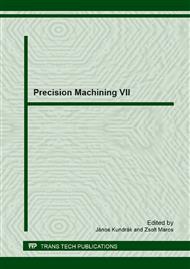[1]
C. Felho, J. Kundrák, Characterization of topography of cut surface based on theoretical roughness indexes, Key Engineering Materials 496 (2011) 194-199.
DOI: 10.4028/www.scientific.net/kem.496.194
Google Scholar
[2]
J. Kundrák, G. Varga, Possibility of reducing environmental load in hard machining. Key Engineering Materials 496 (2011) 205-210.
DOI: 10.4028/www.scientific.net/kem.496.205
Google Scholar
[3]
S. Tsurimoto, T. Moriwaki, M. Nagata, Machinability of CBN tool in turning of tungsten carbide, Key Engineering Materials 523-524 (2012) 70-75.
DOI: 10.4028/www.scientific.net/kem.523-524.70
Google Scholar
[4]
W. Zębala, J. Siwiec, hard turning of cold work tool steel with CBN tools, Advances in Manufacturing Science and Technology, 36/4 (2012) 19-32 (ISSN 1895-9881) DOI: 10. 2478/v10264-012-0023-2.
Google Scholar
[5]
Z. L. Han, B. Lin, B. X. Zhang, L. Zhang, Design Optimization of Cutting Parameters in Turning 45Cr Steel Using Cermets Tool, Key Engineering Materials 443 (2010) 238-243.
DOI: 10.4028/www.scientific.net/kem.443.238
Google Scholar
[6]
A. K. Khare, Thermo-Mechanical Processing and Properties of Forged High Strength, High Toughness Precipitation Hardened Steel, Key Engineering Materials, 84 – 85 (1993) 357-378.
DOI: 10.4028/www.scientific.net/kem.84-85.357
Google Scholar
[7]
W. Zębala, Tool stiffness influence on the chosen physical parameters of the milling process, Bulletin of the Polish Academy of Science -Technical Sciences, 60/3 (2012), 597-604, DOI: 10. 2478/v10175-012-0071-0.
DOI: 10.2478/v10175-012-0071-0
Google Scholar
[8]
W. Zębala, Modelling Researches of the vibrations influence on the cutting process. Advances in Manufacturing Science and Technology 29/4 (2005) 99-107 (ISSN 0137-4478).
Google Scholar
[9]
S.Y. Luo, Y.S. Liao, Y.Y. Tsai, Wear characteristics in turning high hardness alloy steel by ceramic and CBN tools. Journal of Materials Processing Technology, 88, 1-3(1999), pp.114-121.
DOI: 10.1016/s0924-0136(98)00376-8
Google Scholar
[10]
W. Zębala, B. Słodki, Cutting data correction in Inconel 718 turning, International Journal of Advanced Manufacturing Technology, 65, 5-8 (2013) 881-893, DOI 10. 1007/s00170-012-4225-x.
DOI: 10.1007/s00170-012-4225-x
Google Scholar
[11]
I.S. Jawahir, C.A. vom Luttervelt, Recent developments in chip control research and applications. Ann CIRP 42, 2 (1993) pp.659-685.
DOI: 10.1016/s0007-8506(07)62531-1
Google Scholar
[12]
T. Chen, F. G. Yan, C. Y. Wu, H. M. Pen, X. L. Liu, Effect of Chamfered PCBN Tool Edge Geometries on Hard Turning Process, Key Engineering Materials vol. 375-376, 187-191.
DOI: 10.4028/www.scientific.net/kem.375-376.187
Google Scholar
[13]
Z. Q. Liu, P. Zhang, P. Guo, X. Ai, Surface roughness in high feed turning with Wiper insert, Key Engineering Materials vol. 375-376, 406-410.
DOI: 10.4028/www.scientific.net/kem.375-376.406
Google Scholar
[14]
Sandvik Coromant catalogue 2010-(2012).
Google Scholar


